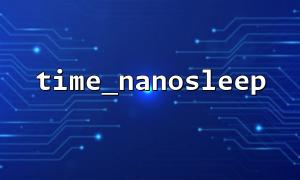When writing high-performance or time-sensitive PHP applications, sometimes we need the program to pause execution for very short periods of time, such as milliseconds or even finer microseconds or nanosecond levels. This requirement is particularly important when handling precision timing control, throttling requests, or interacting with hardware. Fortunately, PHP provides a built-in function time_nanosleep() that enables pauses that are accurate to nanoseconds. This article will take you into the deep understanding of the usage and precautions of this function, and provide multiple practical examples to help you master it flexibly.
time_nanosleep() is a function in PHP that pauses the program to specify seconds and nanoseconds. The function signature is as follows:
bool time_nanosleep ( int $seconds , int $nanoseconds )
$seconds : integer, indicating the number of seconds to pause.
$nanoseconds : Integer, indicating the number of nanoseconds to pause (between 0 and 9999999999).
This function can be used to pause any time less than one second, thereby achieving sub-second-level delay.
PHP also has two commonly used pause functions: sleep() and usleep() . The differences between them are as follows:
sleep(int $seconds) : Only accurate to seconds.
usleep(int $microseconds) : accurate to microseconds (one millionth of a second).
time_nanosleep(int $seconds, int $nanoseconds) : supports accurate to nanoseconds (one billionth of a second).
Therefore, time_nanosleep() is a better choice when you need higher precision time control.
Here is a simple example of using, pausing for 0.5 seconds (ie 500 milliseconds):
<?php
echo "Start: " . microtime(true) . PHP_EOL;
time_nanosleep(0, 500000000); // pause 0.5 Second
echo "End: " . microtime(true) . PHP_EOL;
?>
The output will look like:
Start: 1716026901.12345
End: 1716026901.62346
As you can see, the program paused for about 0.5 seconds.
Suppose you want to execute a certain piece of code every 200 milliseconds, you can use the following method:
<?php
for ($i = 0; $i < 5; $i++) {
echo "Tick $i at " . microtime(true) . PHP_EOL;
time_nanosleep(0, 200000000); // 200 毫Second
}
?>
This writing method can be effectively used in scenarios such as sending throttling requests, timing output logs, polling sensors, etc.
time_nanosleep() may return in advance due to signal interruption (such as POSIX signals) in some systems and return false . In this case, a loop retry mechanism can be used.
<?php
$seconds = 0;
$nanoseconds = 250000000; // 250 毫Second
do {
$result = time_nanosleep($seconds, $nanoseconds);
} while ($result === false && ($error = error_get_last()) && strpos($error['message'], 'interrupted') !== false);
?>
Although most ordinary applications will not encounter such interrupts, this type of protection is recommended in multi-threaded or highly concurrency environments.
Suppose you are developing an API for hardware devices that needs to poll the data interface every 1 millisecond, you can write it like this:
<?php
$url = 'https://gitbox.net/api/device/status';
for ($i = 0; $i < 1000; $i++) {
$response = file_get_contents($url);
echo "[$i] Response: $response" . PHP_EOL;
time_nanosleep(0, 1000000); // 1 毫Second
}
?>
This writing method can perform high-frequency data pull without causing CPU occupation explosion.
time_nanosleep() has been available since PHP 5 and is available in almost all mainstream versions.
It can run on both Windows and UNIX-like systems.
Although it supports nanosecond incoming, the accuracy is actually dependent on the system clock resolution. On some platforms, the minimum accuracy may still be in microseconds.
time_nanosleep() is a powerful but often overlooked function in PHP. It provides developers with the ability to subtly control program pause time, especially for tasks that require high time control. Through the explanation and examples of this tutorial, you should be able to master how to flexibly apply it to improve the control and performance of your application. As long as you pay attention to interrupt handling and system restrictions in use, time_nanosleep() can be used safely and accurately in various scenarios.














